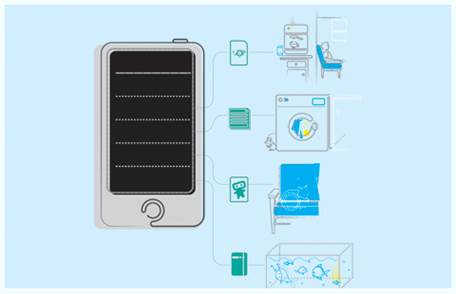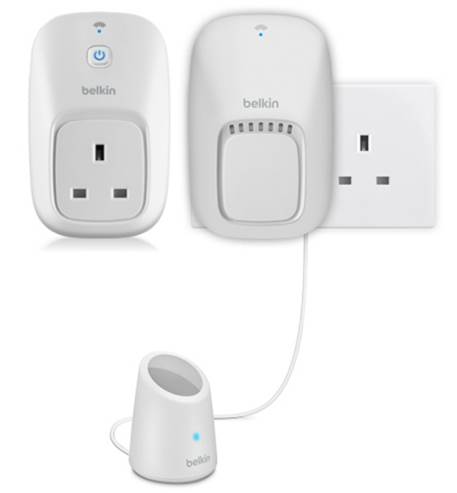Thingternet (n) 1. A Portmanteau of
“thing” + “internet”. 2. A network of objects connected to other objects, via
the internet. 3. The future.
On any given day the internet will deliver
around 300 billion emails, help YouTubers upload the equivalent of 35,000
films, and support the digital lives of 2.27 billion people. The internet is a
rather busy place. But busy as it is, we’re still at the very beginning of the
internet’s big bang. How so? Because all of these examples, at some stage,
involve people – people typing messages, people uploading videos, people
stalking fellow humans on social networks. This kind of human-powered
internetery is soon going to seem rather small and frivolous. In the internet
of the near future, most traffic will take the form of a perpetual, global
chatter from sensor equipped machines and objects. The physical world will go
online and unlike your Facebook friends, its sole aim will be to lubricate
life’s annoying frictions and to make your existence easier. Welcome to the
thingternet.

Thingternet
(n) 1. A Portmanteau of “thing” + “Internet”.
Here’s The Thing
Futuristic as it sounds, the idea of an ‘internet
of things’ is far from new. Invent a Holic Nikola Tesla predicted it in the
1920s, and in the 1990s influential Xerox scientist Mark Weiser spoke of the
rise of ‘ubiquitous computing’. “Ubiquitous computing is roughly the opposite
of virtual reality,” he explained. “While virtual reality puts people inside a
computer-generated world, ubiquitous computing forces the computer to live out
here in the real world with people.”
That scenario was slightly beyond the 56k
modems of the time but luckily for us, two recent tech advances have given the
thingternet a crucial springboard. In February 2010 we ran out of fresh IP
addresses, but a new protocol called IPv6 arrived with longer URLs. Creating more
than 340 Undecillion (that’s 340 trillion trillion trillion) possible
addresses. It’s enough to give every atom on the surface of the Earth a unique
address on the internet. Try cybersquatting on all of them. Equally important
is the arrival of cheap, smart sensors and affordable, long-life chips such as
ARM’s Flycatcher. Consider the RAD750 PowerPC microprocessor in the Curiosity
Mars rover. Your phone is ten times as powerful, but Curiosity’s brain is built
to deal with high-energy cosmic rays and anything a 15-year space mission could
throw at it running sensors and chips on Earth is a cinch in comparison. But it
raises one question – the components may be cheap and long-lived, but how will
we power the millions that a thingternet will require?
Power Rangers
That little poser was answered in May 2012
by researchers at the Korea Advanced Institute of Science and Technology. They
announced the development of a simple, low-cost Nano generator that can convert
vibrational and mechanical forces such as wind and wave movement into electric
current. Zhong Lin Wang, lead scientist at the Georgia Institute of Technology,
which is also developing Nano generators, believes they’ll be a revolutionary
fuel for the thingternet. “[They] are poised to change lives,” he says. “Their
potential is only limited by one’s imagination.” Not that the tech world has
been short on imagination when it comes to connecting ‘things’ to the internet.
Nike+ has been using web-connected sensors to get our trainers hooked up since
2006. Withings’ family of smart health gizmos, which first appeared in 2009,
all use simple sensors to connect to devices such as smartphones and tablets. And
this year, Berg’s Little Printer gave us a smooth implementation of the
thingternet, in the form of a web-connected printer that feasts on feeds to
produce snack-sized, thermal-printed updates.

That
little poser was answered in May 2012 by researchers at the Korea Advanced
Institute of Science and Technology.
Year Of The Thingternet
A future issue of Stuff-May well mark 2012
as the moment the Thingternet sparked into life. There are products everywhere:
Evernote’s Smart Book /Thingternet is a Moleskine notebook that works with the
app to scan text recognized pages straight to your Evernote account, while the
Insteon Light Bulb ($30,smarthome.com) networks directly to your smartphone.
New systems such as Mavia, Green Goose or Belkin’s WeMo home automation (see
boxes) show how simply we’ll be able to communicate and interact with almost
every object.

Belkin’s
WeMo home automation shows how simply we’ll be able to communicate and interact
with almost every object.
This slickly packaged tech isn’t the only
way to bring the thingternet into your life. Kickstarter projects such as Twine
(from US$100, supermechanical.com/twine) are sensor packed boxes that connect
your appliances to a cloud service and have you define rules for them for
example, ‘send me a tweet when the laundry’s done.’ For even more DIY types,
there’s the Arduino microcontroller or Electric Imp (from US$25,
electricimp.com), an SD card-shaped, Wi-Fi enabled chip for easy Thingtegration.